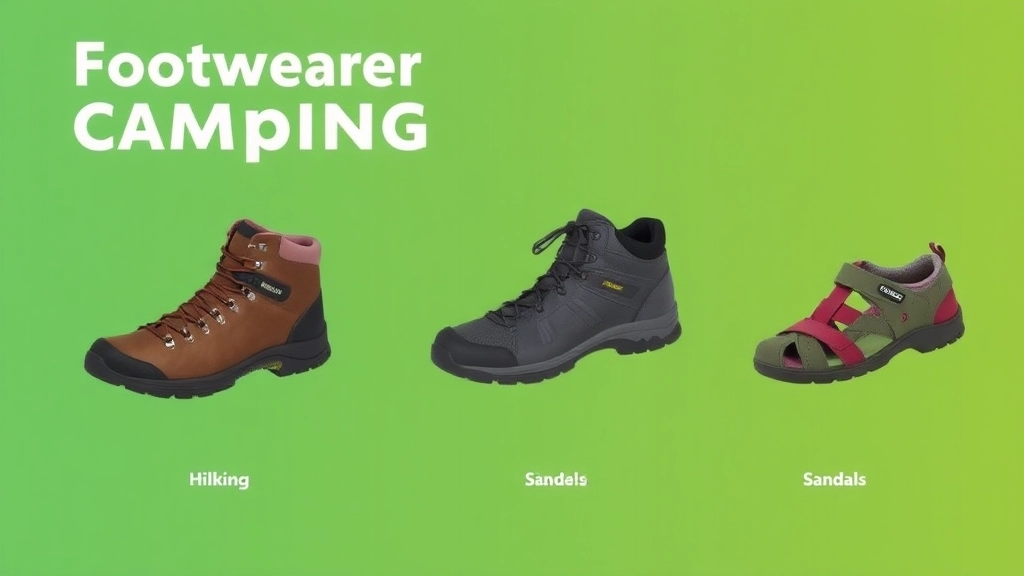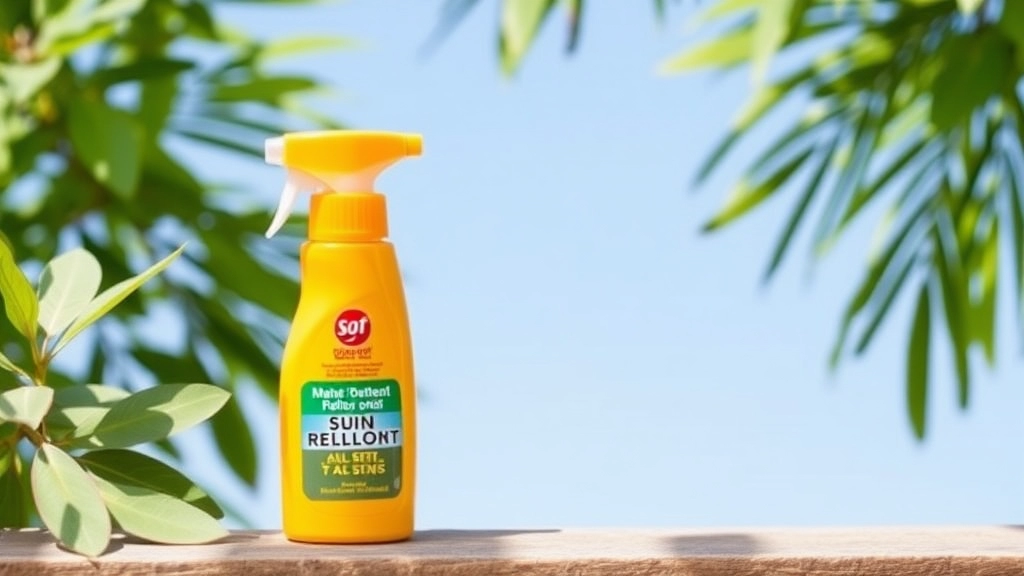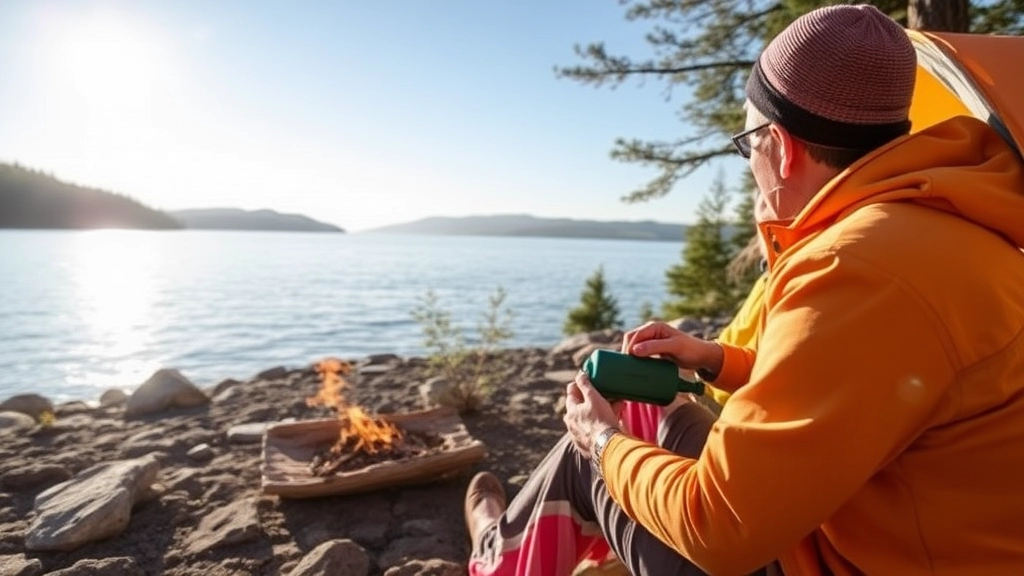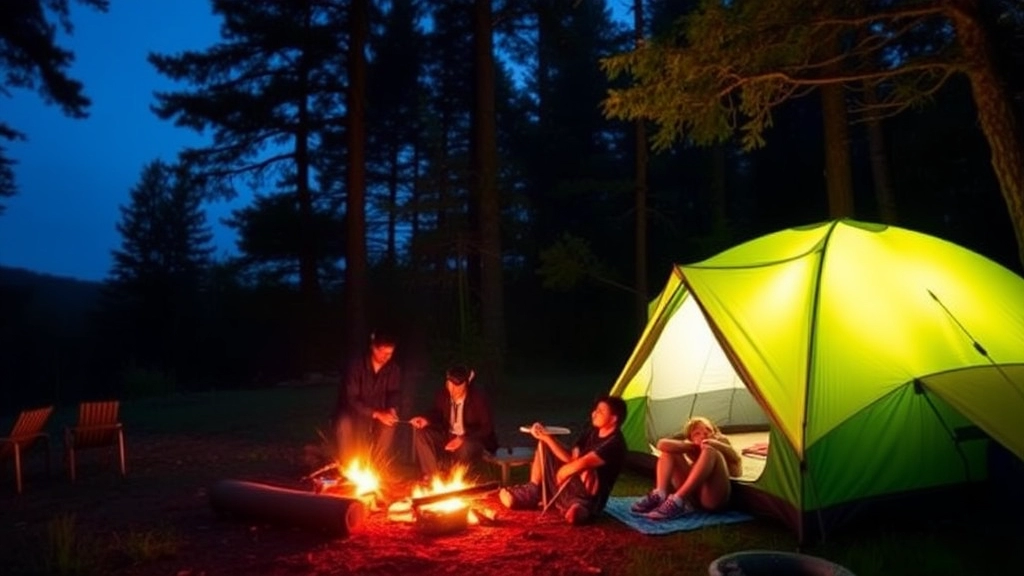Summer Camping Attire
Summer camping is all about embracing the great outdoors, but choosing the right attire can make or break your experience. In this article, we’ll dive into what to wear camping in the summer, from selecting the perfect fabrics to ensuring you’re prepared for unpredictable weather. Whether you’re hiking, lounging, or swimming, we’ve got you covered with tips on staying comfortable and protected.
Essentials for Summer Camping
We’ll explore the essentials like breathable fabrics, layering for cooler nights, and the right footwear for any adventure. Plus, we’ll share insights on sun protection, insect repellent, and the importance of moisture-wicking clothing.
Avoiding Common Pitfalls
Avoid common pitfalls by steering clear of certain materials and discover how the right swimwear can enhance your water activities. Let’s make sure your summer camping trip is nothing short of amazing!
Choosing the Right Fabrics for Summer Camping
Alright, let’s talk about the one thing that can make or break your summer camping trip: choosing the right fabrics. Ever been out in the wild, sweating buckets, and thinking, “Why did I wear this?” Yeah, me too. So, let’s get this sorted.
Why Fabrics Matter
First off, the fabrics you pick can either keep you cool and comfy or turn your trip into a sweaty nightmare. Imagine being out there, under the blazing sun, and your clothes are sticking to you like cling film. Not fun, right? Here’s the deal:
- Breathability: You need fabrics that let your skin breathe. Think about it â your body needs to regulate its temperature, and breathable fabrics help with that.
- Moisture-Wicking: Nobody likes feeling damp. Moisture-wicking fabrics pull sweat away from your skin, keeping you dry.
- Quick-Drying: If you get caught in a sudden downpour or decide to take a dip, quick-drying fabrics can save you from hours of discomfort.
Top Fabrics for Summer Camping
So, what are the best fabrics for summer camping? Here’s the lowdown:
- Cotton:
- Pros: Super comfy and breathable.
- Cons: Holds onto moisture like it’s going out of style. You’ll stay wet for ages if it gets damp.
- Merino Wool:
- Pros: Breathable, moisture-wicking, and naturally odour-resistant. Perfect for multi-day trips.
- Cons: Can be a bit pricey.
- Synthetic Blends (like polyester and nylon):
- Pros: Lightweight, moisture-wicking, and quick-drying.
- Cons: Can retain odours and might not be as breathable as natural fibres.
- Bamboo:
- Pros: Soft, breathable, and eco-friendly.
- Cons: Can be less durable than other options.
Real Talk: My Go-To Picks
When I’m packing for a summer camping trip, I usually go for a mix of merino wool and synthetic blends. Here’s why:
- Merino Wool: Perfect for base layers. It keeps me cool during the day and warm at night. Plus, I can wear it for a few days without it getting stinky.
- Synthetic Blends: Great for outer layers and anything that might get wet. They dry super fast, so I’m not stuck in soggy clothes.
Quick Tips for Choosing Fabrics
- Check the Weather: Know what you’re up against. Hot and dry? Humid? Rainy?
- Layer Up: Even in summer, nights can get chilly. Layering helps you stay warm without overheating.
- Test It Out: Wear your gear on a short hike before your trip. Better to find out what works (and what doesn’t) close to home.
If you’re looking for more tips on summer camping, check out our Ultimate Guide to Summer Camping Essentials and make sure your trip is both fun and safe. Also, for those planning to camp in specific locations, our guide to bucolic summer camps might provide just the inspiration you need.
Essential Daytime Clothing: Staying Cool and Comfortable

Ever been out camping in the summer and found yourself sweating buckets?
Yeah, me too.
Staying cool and comfortable during the day is crucial.
You don’t want to be the person constantly adjusting their clothes, right?
Here’s the lowdown on what you need.
Breathable Fabrics
First off, breathable fabrics are your best mate. Think cotton, linen, and lightweight synthetics. They let your skin breathe and wick away sweat.
- Cotton: Soft and breathable, but not the best for wicking moisture.
- Linen: Light and airy, perfect for hot days.
- Synthetic Blends: Quick-drying and moisture-wicking.
Loose-Fitting Clothes
Tight clothes? No thanks. Go for loose-fitting clothes. They allow air to circulate and keep you cool. Plus, they’re way more comfortable when you’re moving around.
Light Colours
Dark colours absorb heat. Stick to light colours like white, beige, or pastels. They reflect sunlight and keep you cooler.
UV Protection
Worried about sunburn? Look for clothes with UV protection. Some fabrics come with built-in UV blockers.
Quick-Drying Shorts and Trousers
You’ll likely get wet at some point. Whether it’s from a splash in the river or unexpected rain. Quick-drying shorts and trousers are lifesavers.
Moisture-Wicking Shirts
Sweat happens. A moisture-wicking shirt can make a world of difference. It pulls sweat away from your body and dries quickly.
Hats and Sunglasses
Don’t forget your hat and sunglasses. A wide-brimmed hat offers extra shade. Sunglasses protect your eyes from harmful UV rays.
Real Talk: My Experience
Last summer, I went camping in the Lake District. I made the mistake of wearing a dark, tight t-shirt. Big mistake. I was hot and uncomfortable all day. Switched to a loose, light-coloured shirt the next day. What a game-changer.
Quick Recap
- Breathable fabrics are key.
- Choose loose-fitting and light-coloured clothes.
- Opt for UV-protective clothing.
- Quick-drying materials are a must.
- Don’t forget your hat and sunglasses.
Dressing for Cooler Nights: Layering for Warmth
Alright, let’s talk about a real concern many of us have when summer camping: cooler nights. You know the drillâit’s warm and sunny all day, but as soon as the sun dips, it gets chilly. So, how do you stay warm without turning into a human popsicle? The answer is layering for warmth.
Why Layering Matters
Layering isn’t just some fancy term; it’s a practical way to regulate your body temperature. Trust me, you don’t want to be caught off-guard by a sudden drop in temperature. Here’s why layering is your best friend:
- Versatility: You can add or remove layers as the temperature changes.
- Moisture Management: Layers help wick away sweat, keeping you dry.
- Insulation: Multiple layers trap heat more effectively than one bulky garment.
The Base Layer: Your Second Skin
The base layer is like your second skin. It’s the first line of defense against the cold. Opt for materials that wick moisture away from your body:
- Merino Wool: Soft, breathable, and naturally odour-resistant.
- Synthetic Fabrics: Quick-drying and great for wicking moisture.
The Mid Layer: Trapping Heat
Next up is the mid layer. This is your main source of insulation. Think of it as the layer that traps your body heat:
- Fleece Jackets: Lightweight and warm.
- Down Jackets: Super warm but can be bulky.
- Synthetic Insulated Jackets: Good balance of warmth and weight.
The Outer Layer: Shielding from the Elements
Finally, the outer layer protects you from wind and rain. This is crucial because wind and moisture can quickly sap your body heat:
- Waterproof Jackets: Keeps you dry in case of rain.
- Windbreakers: Essential for windy conditions.
Pro Tips for Layering
Here are some quick tips to make layering work for you:
- Avoid Cotton: Cotton retains moisture, making you feel colder.
- Adjust as Needed: Don’t be afraid to add or remove layers to stay comfortable.
- Pack Extra Layers: Always have an extra layer in your backpack, just in case.
Real Talk: My Camping Experience
Let me share a quick story. Last summer, I went camping in the Lake District. The days were warm, but the nights were freezing. I made the mistake of not packing enough layers. I ended up wearing every piece of clothing I had, including my rain jacket, just to stay warm. Lesson learned: always be prepared for cooler nights.
So, next time you’re planning a summer camping trip, make sure you’re ready for those cooler nights. Layer up, stay warm, and enjoy the great outdoors!
Feel free to check out our other tips on Choosing the Right Fabrics for Summer Camping and Essential Daytime Clothing to complete your camping wardrobe. Happy camping!
Footwear for Camping: From Hiking Boots to Sandals

Ever found yourself staring at your shoe rack, wondering what on earth to pack for a camping trip?
Trust me, I’ve been there.
Choosing the right footwear for camping can make or break your experience.
Here’s the lowdown on what you need.
Hiking Boots: Your Best Mate on the Trails
Hiking boots are the MVPs of camping footwear.
Why?
Because they offer support, protection, and grip.
Key features to look for:
- Ankle support: Keeps you stable on uneven terrain.
- Waterproofing: No one likes soggy socks.
- Breathability: Keeps your feet cool and dry.
Sandals: The Unsung Heroes
When you’re not trekking through the wilderness, you need something lighter.
That’s where sandals come in.
They’re perfect for lounging around the campsite or quick trips to the loo.
What to look for:
- Comfortable soles: Your feet will thank you.
- Secure straps: Keeps them from slipping off.
- Quick-drying materials: Wet feet are no fun.
Trainers: The Versatile Option
If you’re not planning any hardcore hikes, a good pair of trainers can do the job.
They’re comfy, lightweight, and easy to pack.
Why trainers work:
- Versatility: Good for light hikes and casual wear.
- Comfort: Soft and cushy for all-day wear.
- Easy to pack: Takes up less space in your bag.
Footwear Tips and Tricks
Here are some quick tips to keep your feet happy:
- Break in new shoes: Don’t wait until your trip to wear them.
- Pack extra socks: Moisture-wicking ones are best.
- Check the weather: Adjust your footwear accordingly.
Personal Story
I remember one trip where I thought I could get away with just trainers.
Big mistake.
Halfway through a muddy trail, I realised why hiking boots are a must.
Lesson learned.
Rain Gear: Staying Dry in Unpredictable Weather
Alright, let’s talk rain gear. We’ve all been thereâcaught in a sudden downpour while camping, and it sucks. Staying dry in unpredictable weather is crucial for a good camping trip. So, how do you gear up for those unexpected showers?
Why Rain Gear Matters
First off, staying dry isn’t just about comfort. Wet clothes can lead to hypothermia, even in summer. Plus, nobody wants to spend their trip in soggy socks and a drenched hoodie. Let’s make sure you’re ready for whatever the sky throws at you.
Must-Have Rain Gear
Here’s the lowdown on what you need:
- Waterproof Jacket: Look for one that’s breathable yet fully waterproof. Gore-Tex is a top choice. It’s like the gold standard for waterproofing.
- Rain Pants: These are a game-changer. Lightweight and packable, they can save you from a miserable, wet hike.
- Poncho: A poncho is versatile and can cover both you and your backpack. It’s not the most stylish, but who cares when you’re dry?
- Waterproof Footwear: Hiking boots with a waterproof membrane or a pair of waterproof sandals can keep your feet dry.
- Dry Bags: Keep your gear safe and dry. These are essential for protecting your valuables like your phone, camera, and clothes.
Pro Tips for Staying Dry
- Layer Up: Wear moisture-wicking base layers under your rain gear. This keeps sweat away from your skin.
- Ventilation: Choose rain gear with vents to avoid getting sweaty inside. Pit zips on jackets are a lifesaver.
- Pack a Tarp: A lightweight tarp can provide quick shelter during a sudden downpour. Plus, it can double as a ground cover for your tent.
Real Talk: Stories from the Trail
I remember one trip where I thought a cheap poncho would do the trick. It didn’t. Halfway through the hike, it ripped, and I was soaked. Lesson learnedâinvest in quality rain gear. Trust me, it’s worth it.
Avoiding Common Mistakes
- Don’t Skimp on Quality: Cheap rain gear might save you a few quid, but it won’t hold up when you need it most.
- Avoid Cotton: Cotton soaks up water like a sponge and takes forever to dry. Stick to synthetic or wool materials.
- Check the Forecast: Always check the weather before heading out. But remember, forecasts can be wrong. Be prepared for anything.
Need more tips on camping gear? Check out our section on Summer Camp Clothing Essentials. Also, don’t miss our Summer Camp Cabin Guide for more useful advice. Stay prepared and happy camping!
Accessories for Sun Protection and Insect Repellent

Ever been on a summer camping trip and found yourself fried to a crisp or covered in bug bites?
Yeah, me too.
Let’s break down the must-have accessories for sun protection and insect repellent.
Sun Protection: Keep Your Skin Safe
First off, sunburns suck.
They can ruin your trip and your skin.
Here’s what you need:
- Wide-brimmed hat: Keeps the sun off your face and neck. Think of it as portable shade.
- Sunglasses: Protect your eyes from harmful UV rays. Polarised lenses are a game-changer.
- Sunscreen: SPF 30 or higher. Reapply every two hours. Don’t skimp.
- UV-protective clothing: Long sleeves and trousers made from breathable, UV-blocking fabric.
Insect Repellent: Keep the Bugs at Bay
Mosquitoes and ticks are the worst.
They can turn a fun outing into a nightmare.
Here’s your bug battle gear:
- Insect repellent spray: DEET or Picaridin-based. Apply liberally.
- Permethrin-treated clothing: This stuff repels ticks and mosquitoes. Game-changer.
- Mosquito net: Essential for sleeping. Keeps the bugs out while you catch some Z’s.
- Bug-repellent wristbands: Handy for extra protection. Every little bit helps.
Real Talk: My Camping Fiasco
Once, I forgot my hat and sunscreen.
Ended up with a sunburn so bad, I couldn’t move my neck.
And the bugs?
They had a feast.
Learn from my mistakes.
The Bottom Line
Sun protection and insect repellent are non-negotiable.
Pack these accessories to keep your camping trip fun and safe.
Don’t let a sunburn or bug bites ruin your adventure.
Moisture-Wicking and Quick-Drying Clothing: Why It Matters
Ever found yourself drenched in sweat during a hot summer hike, or shivering in damp clothes after a sudden downpour? Yeah, we’ve all been there. That’s why moisture-wicking and quick-drying clothing is a game-changer for summer camping.
Why Moisture-Wicking and Quick-Drying Clothing is Essential
When you’re out in the wild, the last thing you want is to feel uncomfortable because your clothes are clinging to you like a second skin. Here’s why these types of clothing should be on your packing list:
- Stay Dry, Stay Comfortable: Moisture-wicking fabrics pull sweat away from your body and spread it out on the fabric’s surface where it can evaporate quickly. This keeps you dry and comfortable, even during strenuous activities.
- Prevent Chafing: Ever had to deal with chafing? It’s the worst. Moisture-wicking clothes reduce the risk of chafing by keeping your skin dry.
- Temperature Regulation: Quick-drying fabrics help regulate your body temperature. When sweat evaporates, it cools you down, making these clothes perfect for hot days.
- Less Weight to Carry: Wet clothes are heavy and can weigh you down. Quick-drying fabrics are lightweight, making your backpack lighter and your hike easier.
What to Look for in Moisture-Wicking and Quick-Drying Clothing
Not all fabrics are created equal. Here’s what you should look out for:
- Material: Opt for synthetic materials like polyester or nylon. These are excellent at wicking moisture and drying quickly.
- Breathability: Look for clothes with mesh panels or vents. These features enhance airflow and help keep you cool.
- Fit: A snug fit works best for moisture-wicking clothes. Loose clothes can trap sweat and take longer to dry.
Real-Life Example: My First Camping Trip
Let me tell you about my first camping trip. I wore a cotton t-shirt because, well, it was comfortable. Big mistake. After a few hours of hiking, it was soaked with sweat, heavy, and just plain uncomfortable. I learned my lesson the hard way. Now, I always pack moisture-wicking and quick-drying clothes. Trust me, it makes a world of difference.
Quick Tips for Choosing the Best Moisture-Wicking and Quick-Drying Clothing
- Check the Label: Look for terms like “moisture-wicking,” “quick-drying,” or “performance fabric.”
- Test It Out: If possible, try the clothes on and see how they feel. Do they cling to your skin or allow it to breathe?
- Read Reviews: Sometimes, the best advice comes from people who have already used the product. Check out online reviews for real-world insights.
Why It Matters
So, why does moisture-wicking and quick-drying clothing matter? Simple. It keeps you comfortable, light, and ready for whatever nature throws at you. Whether you’re sweating it out on a hike or caught in an unexpected rain shower, these clothes have got your back.
For more tips on staying comfortable during summer camping, check out our guide on summer camping clothes. And if you’re planning a camping trip with kids, don’t miss our ultimate guide to boys and girls summer camps.
Clothing to Avoid When Camping in Summer

Ever been stuck on a hot summer camping trip wearing the wrong clothes?
Yeah, it’s rough.
Let’s make sure that doesn’t happen to you.
Here’s a straightforward guide on what to avoid.
Heavy Fabrics
First up, heavy fabrics.
Think denim, wool, or anything thick.
They trap heat and make you sweat like crazy.
Instead, go for lightweight, breathable materials like cotton or linen.
Dark Colours
Avoid dark colours.
They absorb sunlight and make you feel hotter.
Stick to light-coloured clothing to reflect the sun’s rays.
Non-Moisture-Wicking Materials
Non-moisture-wicking materials are a no-go.
Cotton might be comfortable, but it holds onto moisture.
Opt for moisture-wicking fabrics like polyester or nylon.
Tight Clothing
Tight clothing is another mistake.
It restricts airflow and can lead to chafing.
Loose-fitting clothes allow your skin to breathe and keep you cooler.
Avoid Heavy Layers
Heavy layers are a bad idea.
You might think they’re good for evening chill, but they’ll just weigh you down during the day.
Pack light layers you can easily add or remove.
Synthetic Materials
Watch out for synthetic materials.
Some can be uncomfortable and don’t breathe well.
Natural fibres like cotton or bamboo are better for hot weather.
Footwear Missteps
Don’t bring the wrong footwear.
Heavy boots are overkill unless you’re hiking.
Opt for breathable trainers or sandals for general wear.
Stories and Examples
Remember that one time I wore jeans on a summer hike?
Big mistake.
I was drenched in sweat and miserable.
Learn from my mistake.
Quick Tips Recap
- Skip heavy fabrics: Denim and wool are out.
- Avoid dark colours: Light colours keep you cool.
- Ditch non-moisture-wicking materials: Go for polyester or nylon.
- No tight clothing: Loose fits are better.
- Say no to heavy layers: Pack light and removable layers.
- Beware of synthetic materials: Natural fibres breathe better.
- Choose the right footwear: Breathable trainers or sandals.
Footwear and Socks: Ensuring Comfort and Protection
Alright, let’s talk about something we all worry about when camping: footwear and socks. Ever been on a camping trip where your feet felt like they were on fire or freezing cold? Or worse, covered in blisters? Yeah, it’s the worst. So, how do we make sure our feet stay happy and protected? Let’s dive in.
Why Footwear Matters
When you’re out in the wild, your feet are your best friends. They take you everywhere, so you gotta treat them right. Choosing the right footwear can make or break your camping experience. Here’s what you need to consider:
- Hiking Boots: These are your go-to for rugged terrains. They provide ankle support, which is crucial when you’re navigating rocky paths. Look for boots that are waterproof and have good traction.
- Sandals: Perfect for those lazy afternoons by the lake or when you just want to let your feet breathe. But make sure they have a good grip to avoid slipping.
- Trail Runners: If you’re not into heavy boots, these are a lighter alternative. They’re great for less challenging trails and dry conditions.
Socks: The Unsung Heroes
Now, let’s not forget about socks. They might seem like an afterthought, but the right pair can make a huge difference.
- Moisture-Wicking Socks: These are a game-changer. They keep your feet dry by wicking away sweat, which helps prevent blisters.
- Merino Wool Socks: These are perfect for cooler nights. They keep your feet warm without making them sweaty. Plus, they’re naturally antibacterial, which means less stink.
- Liner Socks: If you’re prone to blisters, wear these under your regular socks. They reduce friction and add an extra layer of protection.
Real Talk: My Footwear Fails
I remember one camping trip where I thought I could get away with just wearing my old trainers. Big mistake. Halfway through a hike, I could feel blisters forming, and by the end of the day, my feet were in agony. Lesson learned: always invest in good footwear. Your feet will thank you.
Quick Tips for Happy Feet
- Break in Your Boots: Never take brand new boots on a camping trip. Wear them around the house or on short walks first.
- Pack Extra Socks: Always bring more socks than you think you’ll need. Wet socks are the worst.
- Foot Powder: Sprinkle some in your boots to keep them dry and fresh.
- Check for Hot Spots: If you feel a hot spot forming, stop and address it immediately. A blister can ruin your trip.
If you’re planning a trip and want to ensure a fun and safe experience, check out this guide to Twin Lakes Summer Camp. For those interested in more specialized activities, consider exploring the top summer ice hockey camps available this year.
Swimwear for Water Activities and Relaxation
Ever been on a camping trip and realised you forgot your swimwear?
Yeah, not fun.
Swimwear is a must for any summer camping adventure.
Whether you’re diving into a lake, paddling down a river, or just chilling by the campsite, the right swimwear makes all the difference.
Why You Need Good Swimwear
Comfort is king.
You don’t want to spend your day adjusting your suit or dealing with chafing.
Look for swimwear that’s:
- Quick-drying
- Comfortable
- Durable
Types of Swimwear
For Men:
- Board Shorts: Great for water sports and lounging.
- Swim Trunks: Versatile and quick-drying.
For Women:
- One-piece Swimsuits: Offers more coverage and support.
- Bikinis: Perfect for sunbathing and swimming.
Features to Look For
- UPF Protection: Shields you from harmful UV rays.
- Built-in Liners: Adds comfort and support.
- Pockets: Handy for small essentials.
Real Talk: My Camping Trip
Last summer, I went camping near a river.
I packed my favourite quick-dry swim trunks.
They were a lifesaver.
After a swim, they dried in no time, and I was ready for the next adventure.
What to Avoid
- Cotton: Takes forever to dry.
- Heavy Fabrics: Weigh you down in the water.
Bonus Tips
- Pack an extra pair.
- Bring a lightweight towel.
- Consider a rash guard for extra sun protection.
Swimwear isn’t just for swimming.
It’s for comfort, protection, and making the most of your summer camping experience.
So, don’t skimp on it.
Make sure it’s on your packing list.
Trust me, you’ll thank yourself later.
For more tips on what to bring, check out our guide on summer camping gear essentials and don’t forget to explore our ultimate guide to summer sports camps for kids for more fun activities.
FAQs: What To Wear Camping In The Summer
What fabrics are best for summer camping?
Breathable fabrics like cotton, linen, and lightweight synthetics are ideal. They allow your skin to breathe and wick away sweat.
Should I wear tight or loose-fitting clothes?
Opt for loose-fitting clothes. They allow air to circulate and keep you cooler, making them more comfortable when moving around.
Why are light colours recommended for camping in the summer?
Light colours like white, beige, or pastels reflect sunlight and keep you cooler compared to dark colours that absorb heat.
Is UV-protective clothing necessary?
Yes, clothes with UV protection can help prevent sunburn and protect your skin from harmful UV rays.
What type of shorts and trousers should I pack?
Choose quick-drying shorts and trousers. They are useful if you get wet from rain or water activities.
What kind of shirts should I wear?
A moisture-wicking shirt is ideal as it pulls sweat away from your body and dries quickly, keeping you comfortable.
Are hats and sunglasses important?
Absolutely. A wide-brimmed hat offers extra shade, and sunglasses protect your eyes from UV rays.
What footwear is best for summer camping?
Hiking boots for trails, sandals for lounging, and trainers for light hikes and casual wear are all good options.
What should I look for in hiking boots?
Key features include ankle support, waterproofing, and breathability to keep your feet dry and comfortable.
Why are sandals useful for camping?
Sandals are great for non-hiking activities. Look for ones with comfortable soles, secure straps, and quick-drying materials.
Can I just wear trainers?
If you’re not planning any hardcore hikes, trainers are versatile, comfortable, and easy to pack.
What sun protection accessories should I bring?
Essential items include a wide-brimmed hat, sunglasses with polarised lenses, sunscreen with SPF 30 or higher, and UV-protective clothing.
How can I protect myself from insects?
Use insect repellent spray with DEET or Picaridin, wear Permethrin-treated clothing, use a mosquito net for sleeping, and consider bug-repellent wristbands.
What clothing should I avoid when camping in summer?
Avoid heavy fabrics like denim and wool, dark colours, non-moisture-wicking materials, tight clothing, heavy layers, and some synthetic materials that don’t breathe well.
What footwear should I avoid?
Avoid heavy boots unless you’re hiking. Opt for breathable trainers or sandals for general wear.
References
-
REI: Sun Protection Clothing
-
Outdoor Research: Why You Should Wear UV Protective Clothing
-
Backpacker: How to Choose the Best Hiking Boots

